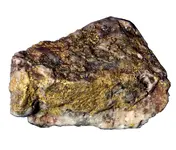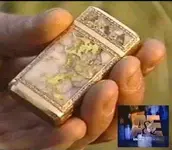Cactusjumper wrote
Roy,
I believe Dr. Thomas Glover did the most extensive testing of the "claimed" LDM ore. He did a very good write-up of those tests. On page 275 he writes: "Further, the entire premise that the ore could be tested against ore from every known mine in Arizona is ludicrous. No one, nor any institution, has such a collection of gold ores. It does not exist."
Thomas put a lot of time, effort and money into seeking anything that came close to such a collection. He came up with nada.
NO disrespect intended to Dr Glover and I consider him a friend, but you know that the testing he had done, was limited to non-destructive methods. No assay was done. At least one of the specimens he was provided is questionable too. He will tell you himself that the testing he had done, was quite
limited in scope.
As to the collection, I would suggest checking with the Flandrau Science Center, Department of Geosciences, The University of Arizona Mineral Museum as I understand
the collection is on public display from February until May. People that live or are visiting AZ could see it for themselves. By the way you can find the signed affidavits concerning the ore comparison in Helen Corbin's first book, I believe they are in the back pages, so unless the affidavitd were baldfaced lies, I don't dismiss them even though one of the two men now has changed his views on the LDM to believe that it never existed in the Superstitions as he recently posted on Facebook.
Cactusjumper also wrote
Not knowing crap about rocks, I will assume that you are correct. One word that I picked up out of the above post was
"normally". From what I have read, the LDM is anything but normal.
Would love to have you and Beth spend some time with us next time you are out this way.
Taking that last part first, I would say ditto - we do have one or two things to see and do in this part of the country too, especially if you had a way to bring along a quad.
Why would you say the LDM is anything but normal? I would say it is very much normal,
for the type of gold deposit it appears to be, and would fit the statements attributed to Waltz very well. Perhaps even one of the famous "chimney" type deposits the old timers used to dream of finding, which would not necessarily look like much on the surface of the ground, as was the case with the Vulture mine. As you know the big majority of gold deposits in Arizona were found to be epithermal type, which normally (and commonly) will pinch out at a relatively shallow depth, so the mines would play out quickly, resulting in many a ghost town across the state <and in many states as well> where high hopes were dashed when the veins pinched out. Hypothermal veins tend to run
very deep, hundreds or even thousands of feet deep, and are often very rich - like the Vulture and the results Dick Holmes got on his assay - really the best kind of hard rock gold mine to find.
Azdave35 wrote
roy...i'm pretty thick skinned...nothing you said offended me and i meant no offense to you...but you are wrong about not many people driving 2400 miles just to spend a short time in the supers...alot of people come alot farther than that...they come from all over the world to hang out on that rock they call the superstition mountain....and just because i live here doesnt mean i know everything about the lost dutchman mine....but i know alot more than most...the main thing i know is i stopped looking for it a long time ago...because its already been found....and even if it hadnt been found and cleaned out i still wouldnt waste my time looking for it...over the years i've known quite a few dutch hunters that spent their whole life looking for that mine and they have nothing to show for it except a divorce..kids that wont have anything to do with them..they have spent time in jail because of their quest.....i'd rather look for something i can find
You have made a couple of strong statements there, one of which I would like to ask to see some support for? You state that the mine was found, perhaps already cleaned out? Can you say who or whom found it, and what proves that what they found, IS the same mine of Jacob Waltz? Or what led you to believe this? Thanks in advance, and for the record, we can disagree on things and it has no bearing on friendship in my view.
To all - the fact that so many have searched for this lost mine for so long without success, leads people to many kinds of conclusions to explain it. The mine must never have existed, or he was stealing it from somewhere else, or it was found and all cleaned out etc. This may just be the natural inclination to reject something which is very difficult to solve, and finding the Lost Dutchman's mine has to be one of the most difficult there are. I know that a LOT of people do
not agree with what I posted, including many of our most highly respected experts on this topic, which is why I really hesitated about saying anything at all. Probably said too much as it is. I won't derail the discussion any further, please do continue amigos.
Good luck and good hunting amigos, I hope you find the treasures that you seek.
Oroblanco












